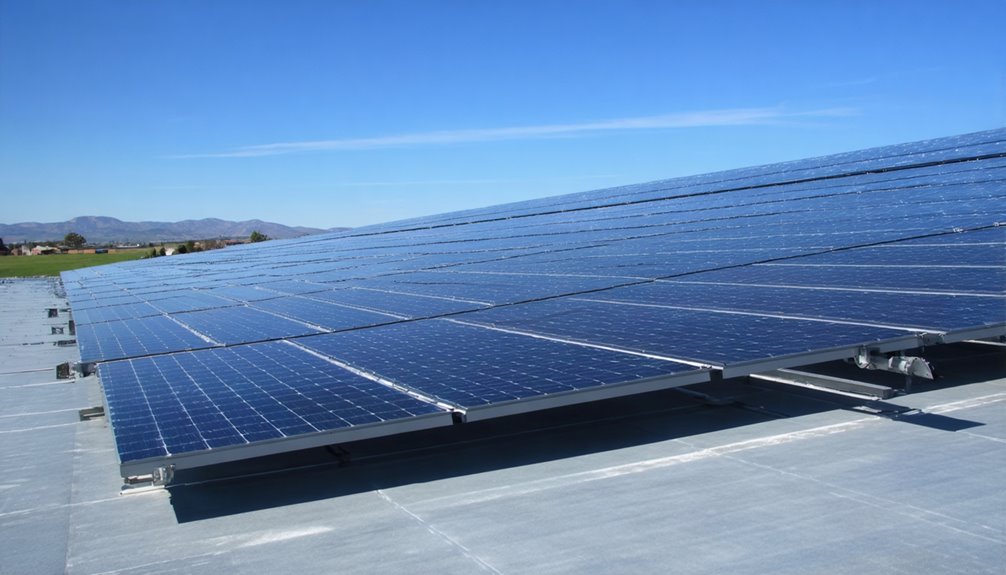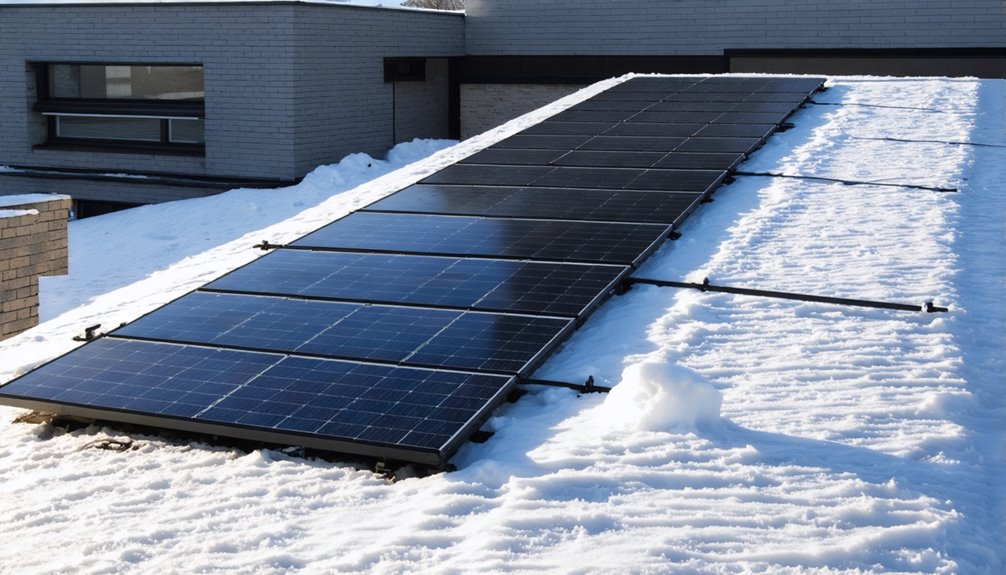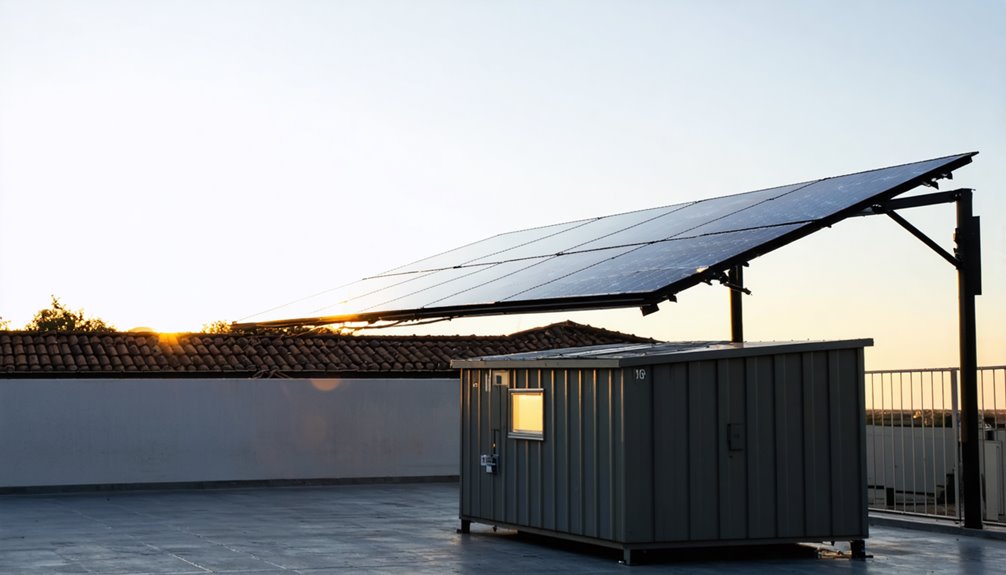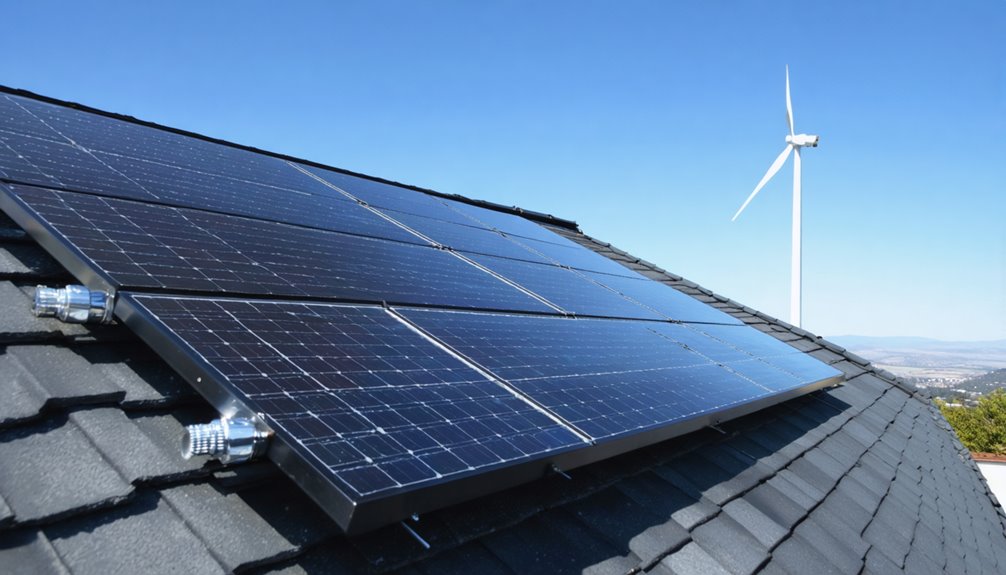For optimal solar panel efficiency, align your panels to the latitude of your home. Ideally, adjust the tilt seasonally: in summer, use latitude × 0.92 – 24.3º; in winter, latitude × 0.89 + 24º; and in spring/autumn, latitude × 0.98 – 2.3º. Fixed systems might be simpler, but adjustable ones capture more energy. Always assess your roof’s strength and environmental conditions. Discover more about enhancing solar performance through strategic tilt adjustments and professional consulting.
Importance of Solar Panel Tilt Angles
When installing solar panels, understanding the significance of tilt angles is vital, as they directly influence the system’s energy production efficiency. The ideal tilt angle is essential to capturing maximum sunlight, typically aligning with your home’s latitude. This alignment guarantees solar panels absorb the right amount of sunlight throughout the day. In the U.S., solar panel tilt angles from 30-45 degrees are commonly recommended, maximizing energy production across various locations. Seasonal adjustments can further enhance efficiency, custom-fitting tilt angles for summer and winter guarantees panels are in harmony with the sun’s path, reducing potential energy losses of up to 8% seen with non-ideal angles. For instance, at a 40-degree latitude, a solar panel installation would ideally use a 33.5-degree tilt. Additionally, before making tilt adjustments, ensure a professional assessment of the roof’s structural load structural load and condition.
Determining the Optimal Solar Panel Angle
To determine the ideal solar panel angle, you’ll first want to take into account your home’s latitude, as the angle should generally match this measurement, such as a 30-degree tilt for a 30-degree latitude. Seasonal adjustments are also beneficial; during summer, tilting the panels lower increases sun exposure, whereas raising the angle in winter helps capture more sunlight due to its altered path. Although fixed angles can be efficient, making these seasonal modifications can enhance energy collection by over 4% in peak seasons, underscoring the importance of aligning your setup with geographic and seasonal factors. Additionally, choosing between fixed-tilt and tracking mounts can affect the long-term economics, influencing the overall cost per watt.
Latitude’s Impact on Angle
How does latitude affect the ideal angle at which solar panels should be installed? Latitude’s impact is vital in determining the best solar panel angle for maximum energy capture. Generally, you should match the tilt of your panels to the latitude of your location. For instance, in Los Angeles, a 34-degree angle aligns with its latitude, while New York City benefits from a 41-degree tilt. As latitude increases, the efficiency of energy capture can decrease if the angle deviates from this best setting. Although seasonal angle adjustments, such as changing the angle to latitude × 0.92 – 24.3º in summer and latitude × 0.89 + 24º in winter, can fine-tune energy capture, the baseline tilt should align with your specific latitude to maximize efficiency.
Seasonal Tilt Adjustments
Understanding how latitude determines the fixed angle for solar panels lays a foundation for appreciating the significance of seasonal tilt adjustments aimed at enhancing energy capture throughout the year. Seasonal tilt adjustments improve how solar panels work by varying the tilt angles to maximize sunlight exposure and energy efficiency. For summer, calculate the ideal tilt by using latitude × 0.92 – 24.3º, while winter months benefit from latitude × 0.89 + 24º for maintaining energy capture. During spring and autumn, adjust your solar panels to latitude × 0.98 – 2.3º for balanced energy collection. Compared to fixed panels, which lack efficiency in shifting seasons, simple adjustments can improve your annual collection by 4-5%. Especially in colder climates, implementing a winter tilt boosts energy production during high demand months.
Latitude’s Influence on Panel Tilt
Latitude plays an essential role in determining the ideal tilt angle for solar panels, as the best tilt generally corresponds to the latitude of the installation location, ensuring maximum exposure to sunlight throughout the year. For instance, in areas like Houston with a latitude of 30° N, a 30-degree tilt is suggested, while in Denver, where the latitude is 40° N, a steeper 40-degree angle is appropriate to capture the sun’s rays effectively. By employing latitude-based formulas, such as multiplying latitude by 0.87 for locations below 25° and using latitude × 0.76 + 3.1° for those between 25° and 50°, you can make precise tilt adjustments to enhance solar energy capture, especially important during winter months when the sun is lower in the sky.
Latitude Determines Ideal Tilt
For ideal solar energy collection, the tilt angle of solar panels should align closely with the latitude of the installation site, which means if you’re positioned at a latitude of 30 degrees, it’s typically recommended to set your panels at an equivalent tilt of 30 degrees. Adjusting the tilt to align with latitude not only guarantees energy efficiency but enhances solar energy output. In the northern hemisphere, failing to make these tilt adjustments could lead to a reduction of up to 8% in energy production. Utilizing formulas like latitude × 0.76 + 3.1º for fixed tilts effectively tailors the panel angle. The ideal angle is pivotal to capturing sunlight effectively throughout the year and maintaining peak efficiency.
| Latitude | Winter Angle | Summer Angle |
|---|---|---|
| 30° | 45° | 18° |
| 35° | 50° | 21° |
| 40° | 55° | 24° |
| 45° | 60° | 27° |
| 50° | 65° | 30° |
Tilt Adjustments by Latitude
While aligning your solar panel’s tilt with the latitude of the installation location is fundamental to maximizing solar energy efficiency, it’s important to recognize that adjustments are necessary as you move across different latitudinal zones. The ideal tilt angle generally matches the latitude but requires modifications when addressing specific regional characteristics to guarantee effective energy collection. For areas below 25º latitude, you should calculate the angle adjustments using latitude multiplied by 0.87. In regions between 25º and 50º latitude, use the formula latitude multiplied by 0.76 plus 3.1º. Above 50º latitude, adjusting for the reduced insolation levels becomes essential. Additionally, for seasonal optimization, adjust tilt by multiplying the latitude by 0.89 plus 24º during winter, and by 0.92 minus 24.3º for summer.
Latitude-Based Tilt Recommendations
Understanding how latitude affects the tilt of solar panels is critical for maximizing energy efficiency. The ideal tilt angle, closely aligned with the latitude of your installation location, guarantees your solar panels capture the maximum possible solar energy. For latitudes below 25º, you’ll want a tilt that’s about 87% of your latitude; for instance, a 20º latitude requires a 17.4º tilt. When your latitude lies between 25º and 50º, apply the formula: latitude × 0.76 + 3.1º, resulting in a 33.5º tilt at a 40º latitude. If your installation is above 50º latitude, consider specific tilt recommendations due to potential solar exposure challenges. Employing adjustable tilt systems seasonally can enhance solar capture, offering superior energy efficiency over fixed setups.
Fixed vs. Adjustable Tilt Systems
Although many solar energy systems prioritize simplicity, deciding between fixed and adjustable tilt systems demands a thorough understanding of their distinct advantages. Fixed panel systems offer ease of installation and require no angle changes, yet they fall short in energy capture compared to adjustable systems. With the ability to make seasonal adjustments, adjustable systems optimize sunlight absorption, boosting efficiency from a fixed system’s 71.1% to 75.2% with just two adjustments per year. Although two-axis trackers achieve peak efficiency at 100%, they are more complex and costly. Evaluating whether a fixed panel’s simplicity suffices or if adjustable systems’ angle changes for seasonal adjustments enhance energy capture is essential in determining the most suitable approach to solar energy installation. Additionally, mounting considerations should also account for local wind loads and roof strength, wind loads, when choosing between fixed and adjustable systems.
Seasonal Adjustments for Maximum Output

To guarantee your solar panels maximize energy capture throughout the year, it’s essential to adjust their tilt angle seasonally using specific formulas, such as latitude × 0.92 – 24.3° for summer and latitude × 0.98 – 2.3° for spring and autumn. Seasonal adjustments can be complemented by single-axis trackers in appropriate sites to boost annual yield. By adapting the panels’ position to account for the sun’s varied path across seasons, you can greatly enhance energy efficiency, with potential improvements of around 4% compared to non-adjustable systems that typically capture 71.1% of available solar energy. Regular seasonal adjustments also help mitigate energy loss by guaranteeing the panels consistently face the best angle, thereby increasing the potential for capturing up to 88% of the energy possible with more complex tracking systems.
Optimal Seasonal Tilt Strategies
Implementing ideal seasonal tilt strategies for solar panels is essential for maximizing energy output throughout the year. By setting the best angle for solar panels, you can guarantee significant enhancement in energy collection. Seasonal adjustments, such as tilting the panels at latitude × 0.92 – 24.3° during summer, latitude × 0.98 – 2.3° in spring/autumn, and latitude × 0.89 + 24° in winter, can lead to efficient energy capture. These calculations suggest that a solar panel at 40° latitude should be tilted to 30.7° in summer, 37.9° in spring/autumn, and 64° in winter, assuring excellent performance. Regularly adjusting these angles keeps the panel aligned with the sun’s position, thereby enhancing the overall energy collection throughout each season.
Adaptation for Sun Position
Since ensuring ideal solar panel performance involves effectively adapting to the sun’s changing position throughout the year, making periodic seasonal adjustments can greatly enhance energy efficiency. To enhance energy capture, adjust your solar panels twice a year based on their angle and direction relative to the sun’s movement. During summer, set the best angle using the formula: latitude × 0.92 – 24.3º, while in spring/autumn, use latitude × 0.98 – 2.3º. For winter, a steeper tilt of latitude × 0.89 + 24º maximizes sunlight exposure and aids in snow shedding. Without these seasonal adjustments, fixed panels might lose up to 8% efficiency. By aligning with the sun’s position, you’ll harness approximately 75.2% of potential energy during these critical seasonal changes.
Benefits of Fixed Winter Tilts

When optimizing solar panel performance during colder months, adopting a fixed winter tilt presents significant advantages, as it enhances energy capture by aligning panels to specific winter angles that improve efficiency even amidst inclement weather. By setting your panels at fixed winter angles, you maximize energy production, effectively capturing solar gain, especially in areas such as those at 40º latitude where a tilt of approximately 59.6º yields substantial insolation rates of 4.7 kWh/m². This method proves remarkably effective, capturing up to 88% of energy in comparison to ideal tracking systems. Additionally, fixed winter angles facilitate energy capture by allowing panels to shed snow more efficiently, hence ensuring consistent electricity generation. Such configurations not only maximize energy during critical seasons but also support passive solar heating strategies.
Considerations for Roof Pitch
Considering the pitch of your roof is essential for improving solar panel installation, as the slope directly affects the panels’ ability to harness sunlight effectively. Roof pitch, ranging from 4/12 (18 degrees) to 9/12 (37 degrees) for many U.S. homes, greatly influences the ideal angle and solar panel efficiency. A steeper roof pitch often enhances sunlight exposure and allows for better angle adjustments, vital for maximizing energy production. Installers assess your roof’s pitch to make specific mounting system recommendations, aligning with the perfect tilt for capturing maximum sunlight throughout the day and different seasons. By adjusting your mounting system accordingly, you can enhance solar energy collection, boost electricity generation, and realize potential savings on energy bills by leveraging your home’s unique roof pitch. Consider wind and snow loads when selecting mounting systems to ensure durability under local conditions.
Impact of Environmental Conditions
Although environmental conditions often present challenges in solar panel efficiency, they also highlight the need for strategic design and maintenance to enhance energy output. Shading from nearby structures or vegetation can greatly diminish solar panel output by obstructing sunlight exposure, necessitating angle changes for ideal performance. Additionally, geographic factors, such as altitude and weather patterns, influence effective solar panel angles. Higher altitudes may enhance sunlight exposure but are affected by local cloud cover and atmospheric absorption. Seasonal changes require an angle adjustment; a higher tilt might be beneficial during winter when the sun sits lower. Environmental dust and debris can accumulate, reducing energy output, and require regular cleaning. By strategically considering these variables, you can maximize solar panel output throughout the year.
Time-of-Use Rates and Energy Savings

Time-of-use (TOU) rates provide a strategic opportunity for homeowners to maximize their solar energy savings by aligning solar panel production with periods of peak electricity prices. By optimizing the tilt of your solar panels seasonally, you can increase energy production during higher rate periods, capturing more sunlight when demand and costs are greatest, thereby reducing electricity bills. Research indicates that adjusting solar panels’ angle can enhance energy capture by up to 8%, emphasizing the financial benefits.
| Optimization Strategy | Benefit |
|---|---|
| Adjust Solar Panel Angle | Maximize Energy |
| Align with TOU Rates | Lower Bills |
| Seasonal Tilt Changes | Higher Efficiency |
Installing systems with adjustable tilt capabilities allows you to actively respond to TOU schedules, ensuring maximum energy generation when rates peak.
Professional Guidance for Angle Optimization
While installing solar panels on your home, obtaining professional guidance for angle adjustment is crucial to maximize energy efficiency and production. Professionals determine the best solar panel angle by considering your home’s latitude, which aligns your panels for peak sunlight exposure. Expert installers don’t just stop there; they assess unique roof characteristics, such as pitch and shading, guaranteeing your panels achieve peak performance year-round. They consider the seasonal sun position, using their insights to tailor recommendations for both fixed or adjustable tilt systems. This expertise allows for maximizing energy output by balancing simplicity with energy capture. Ongoing consultations post-installation guarantee your system adapts to changing environmental factors, maintaining effective and long-term integration for continuous energy efficiency.
Monitoring and Adjusting for Peak Performance
To guarantee solar panels consistently operate at peak performance, leveraging monitoring tools is essential, as they provide real-time data on energy production relative to panel angles, helping homeowners make informed decisions about necessary adjustments. Monitoring tools, combined with solar performance software, track kilowatt-hours generated daily, offering insights into whether your panels are set at the ideal angle. Seasonal variations in sunlight affect energy output, necessitating regular adjustments to maintain performance efficiency throughout the year. Professional installations should commence with a thorough assessment, setting the stage for future angle adjustments based on reliable monitoring data. Understanding local regulations and incentives can further influence your strategy for performance efficiency, aiding in effective decision-making to guarantee that panels capture maximum sunlight and achieve consistent energy output.
Conclusion
To optimize your solar panel’s efficiency, align its tilt angle with your geographical latitude, adjusting it seasonally for sun position changes and maximizing solar energy harvest. Consider fixed or adjustable tilt systems based on your specific requirements and local environmental conditions, while prioritizing time-of-use rates to enhance energy savings. Rely on professional guidance to determine ideal tilt angles, ensuring continuous peak performance through vigilant monitoring and periodic adjustments, thereby enhancing your solar investment’s output and longevity.
The optimal mounting angle for solar panels depends on your location’s latitude, seasonal variations, and energy usage patterns. Whether you choose a fixed or adjustable mounting system, proper installation and regular monitoring are essential for maximizing energy production and return on investment. Solocity Global serves as a trusted exporter of solar panel mounting systems, providing comprehensive solutions to meet diverse project requirements. Their standards-compliant mounting systems are designed to support optimal panel positioning while ensuring durability and reliability for clients across global markets.


